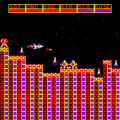The tomb of the Egyptian pharaoh Tutankhamun fascinated the world through much of the 20th century, particularly the rumored “curse” that would afflict anyone who entered. This provided the background for Konami/Stern’s arcade game, Tutankham. (The name is said to be shortened due to its length.) As an unnamed explorer, you brave the dangers of King Tut’s tomb, though you’re heavily armed with a gun and a small amount of flash bombs.
Each of the game’s four stages consists of narrow corridors, filled with treasures, enemy spawning points, and keys, as well as warp points that will teleport you around the map. The arcade cabinet has two joysticks, the left for movement, and the right for attacks. Rather unusually, and this is the key gimmick for the game, you can only shoot your gun left or right. So, the main strategy involves luring enemies out into areas where you can attack them, and try to avoid vertical hallways where you may be defenseless. Foes spawn infinitely though, so this is easier said than done. By pressing up on the right joystick, you’ll detonate a flash bomb, killing everything on the screen, though those only grants a short reprieve.
You also need to find keys to unlock the treasure at the end of the level, and proceed to the next stage. The most annoying aspect of the game is that you can only carry one key at once, and every area beyond the first stage has two locks. So you need to grab a key, get to the end of the stage, then backtrack all the way back to find another key, and then return to the exit to finally beat the level. Combined with the numerous and relentless enemies, it becomes an incredibly difficult experience.Still, the setting is an interesting one, and it’s still fun in spite of how easily it is to get overwhelmed. It has a cool effect when you get killed – you turn into a skull and crossbones and then explode outward, with the pixels actually carving out paths in the backgrounds.
In Japan, Tutankham is unofficially referred to by fans as “King’s Valley 0”, as it’s sort of a predecessor to Konami’s later MSX action-puzzle series. Not only does it have a similar concept (treasure hunting in Egyptian tombs) but the end-level music tune is identical. Tutankham was much more popular in the United States, thanks to its heavily advertised console ports by Parker Brothers. The Atari 2600 is radically altered due to the hardware – rather than scrolling horizontally, it scrolls vertically, and the mazes are simplified to the point where they’re really just straight corridors. Since most of the hallways are horizontal, it generally makes the game easier, though the futzy controls make it easy to get stuck on corners and walls. The graphics are heavily simplified – amusingly, the “map” treasure is just the letters “MAP”. It’s obviously a totally different experience than the arcade game, but on its own, it’s not a bad little run and gun.
The rest of the ports are more faithful, with the Colecovision one being the best. The visuals here are less colorful but the sprites are larger and more detailed (when you get a key, it appears on the explorer’s hat rather than just floating over his body, a nice touch) and it plays very well, with the only compromise being slightly jerky scrolling. It even removes the second locks in the levels, making the game less tedious, and also making it superior to the arcade game. The Intellivison port looks good for the platform, though the action is incredibly slow. The VIC-20 port suffers from squished graphics and a large status bar, but otherwise is a pretty decent conversion. The Odyssey2 version (developed but unreleased) has drastically simplified visuals like the Atari 2600 game though it’s far less colorful. The maze construction is simplified but it’s still a little more faithful to the arcade game. However, the levels are broken up until multiple screens. The Atari 8-bit version (also unreleased) plays well but has a garish color scheme that makes it difficult to play.
In Japan, the only ports were to the Casio PV-1000 and the NEC PC-6001. The latter has tiny sprites, altered levels, and slow gameplay. There were also two handheld consoles by Bandai. A clone made by T&E Soft for the PC-6001 called Pyramid is far superior to Konami’s effort, with improved visuals, and even offers level construction.There was even a slightly updated sequel released called Pyramid II.
There were a number of computer clones of Tutankham in the American marketplace, mostly for type-in magazine. Some of these include King Tut’s Tomb and Lord of the Orbs (both Atari 8-bit), Key Quest (VIC-20), Cuthbert Enters the Tombs (Commodore 64), and The Touchstone (TRS-80). The best of these is DungeonLords (Atari 8-bit), which includes faster gameplay, the ability to shoot in all four directions, and randomly generated mazes.
Tutankham has been missing from most arcade re-releases, though it did appear on Konami Arcade Classics for the DS, where it was renamed Horror Maze for some unknown reason.

